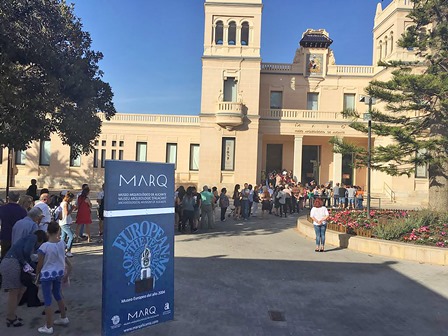
The Maya have led to long queues at the gates of the MARQ throughout the weekend. More from 3,500 people have gone through the new international exhibition museum in Alicante, which has also celebrated its 15th anniversary in its current headquarters, the old provincial hospital, since its inauguration by H.M. Queen Sofia on 28 May 2002.
The President of the Diputación de Alicante, César SánchezAfter presiding over the inaugural event on Thursday 25th with the Guatemalan Minister of Culture, yesterday morning he went to the MARQ with his family to admire "Mayas. The enigma of the lost cities".. For his part, the deputy for Culture, César Augusto AsencioHe was very satisfied with the warm welcome given to the exhibition by the people of Alicante.
The exhibition occupies a total of four rooms, which have been ornamented with a spectacular exhibition design, The first room offers us a journey that takes us from the recreation of the origin of this attractive civilisation through the monumental architecture of the pyramids and the mysteries of the hieroglyphic writing arranged on stelae or lintels. It is precisely this room that has attracted the most attention from the public, who have shown particular interest in the interactive panels and the mysteries of the Mayan calendar.
In the second room, a Mayan temple and with him, the apogee of its culture in the so-called Classical Period with the development of large cities such as Tikal and CalakmulThe second room contains the monumental palaces and the importance of the deified king and his court. The third room houses the great stone realisations: stelae, panels and monumental sculpturesThe paintings of San Bartolo, which bring us closer to the profound beliefs of this civilisation through an understanding of the paintings of San Bartolo. Among them, the figure of a man with the attributes of a jaguarwhich has been highly praised by visitors. Finally, in the Library, and under the suggestive title "Mayas up close", surprising contributions from the Spanish archaeological missions in Guatemala and, in particular, that of the teams of Valencian researchersThis is a fundamental tool to deepen the knowledge of the roots of this fascinating Mesoamerican world.
The impressive collection of Mayan artefacts, made up of almost 200 objects from Guatemalan and German museums, will remain in the Marq. until 7 January next.
